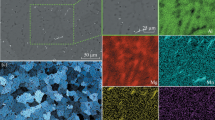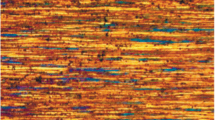Conclusions
-
1.
By homogenization annealing of low-alloy molybdenum alloys supersaturated with carbon that have a subgranular structure it is possible to obtain finely dispersed precipitates of carbide phase evenly distributed in the grains, with a heterogeneity factor of ∼ 1 μ.
-
2.
The structure of the alloy obtained as the result of homogenization annealing depends to a considerable extent on the annealing temperature. The optimal temperature is that at which the rate of “decomposition“ of dislocation boundaries and the rate of precipitation of particles of second phase of critical size in subgrain boundaries are comparable.
-
3.
Finely dispersed particles of second phase evenly distributed in the grains (density μ−3) that are thermodynamically stable at high temperatures stabilize the mechanical properties of the alloy with prolonged holding at high temperature (1500° for 100 h).
Similar content being viewed by others
Literature cited
E. M. Savitskii and G. S. Burkhanov, Metal Science of Alloys of Refractory and Rare Metals [in Russian], Nauka, Moscow (1971), p. 159.
M. V. Mal'tsev and V. I. Shulepov, “Nature of the embrittlement of molybdenum,“ in: Physical Nature of Brittle Fracture of Metals [in Russian], Naukova Dumka, Kiev (1965), p. 125.
A. N. Vergazov, G. A. Korobkova, and V. V. Rybin, “Changes in the defective structure of Mo-Zr-C alloy,“ in: Problems of Shipbuilding [in Russian], Series 7, Shipbuilding Materials, No. 3, Sudostroenie, Leningrad (1973), p. 76.
B. Wilcox, L. Veigel, and A. Clauer, Metall. Trans.,3, No. 1, 273 (1972).
T. M. Afonina et al., “Effect of alloying with titanium, zirconium, and niobium carbides on the structure and properties of deformed and annealed molybdenum alloys,“ Fiz. Met. Melloved.,32, No. 2, 114 (1971).
O. A. Belous et al., “Effect of carbon and zirconium carbide on the ductile-brittle transition temperature of cast molybdenum,“ Prob. Prochn., No. 6, 97 (1971).
D. Robins, J. of Less-Common Metals, No. 1, 396 (1959).
E. V. Belik et al., “Structural changes and cold brittleness of molybdenum during deformation,“ Fiz. Met. Metalloved.,24, No. 3, 535 (1967).
A. Cochradt, G. Snhoek, and H. Wiedersich, Acta Met.,3 No. 5, 533 (1955).
V. D. Verner, Yu. V. Piguzov, and I. Ya. Rzhevskaya, “Interaction of interstitial impurities with dislocations in molybdenum,“ in: Interactions between Dislocations and Impurity Atoms in Metals and Alloys [in Russian], Trudy Tul'skogo Politekhnicheskogo Instituta (1969), p. 89.
Yu. V. Mil'man and V. I. Trefilov, “Effect of alloying with titanium, zirconium, and niobium carbides on the structure and properties of deformed and annealed molybdenum alloys,“ Fiz. Met. Metalloved.,32, No. 1, 115 (1971).
Yu. V. Mil'man and K. P. Ryaboshapka, “Recrystallization of precipitation-hardened bcc alloys,“ Fiz. Met. Metalloved.,32, No. 5, 998 (1971).
N. V. Dubovitskaya and L. N. Larikov, “Growth of subgrains during annealing of deformed molybdenum,“ Fiz. Met. Metalloved.,32, No. 5, 1083 (1971).
C. Zener, Trans. AIME,175, No. 1, 15 (1949).
V. I. Trefilov, “Effect of cellular structure on the behavior of material under load,“ in: Physics of Strain Hardening of Single Crystals [in Russian], Naukova Dumka, Kiev (1972), p. 191.
Yu. I. Poliektov and V. V. Rybin, “Plastic growth of cracks,“ Fiz. Met. Metalloved.,34, No. 6, 1150 (1972).
V. V. Rybin, A. N. Vergazov, and V. A. Likhachev, “Fracture toughness of molybdenum as the result of fragmentation of the structure,“ Fiz. Met. Metalloved.,37, No. 3, 620 (1974).
Additional information
Translated from Metallovedenie i Termicheskaya Obrabotka Metallov, No. 10, pp. 38–44, October, 1976.
Rights and permissions
About this article
Cite this article
Vergazov, A.N., Dushin, Y.A., Emel'yanova, L.I. et al. Distribution of finely dispersed precipitates in low-alloy molybdenum alloys. Met Sci Heat Treat 18, 877–882 (1976). https://doi.org/10.1007/BF00705196
Issue Date:
DOI: https://doi.org/10.1007/BF00705196




